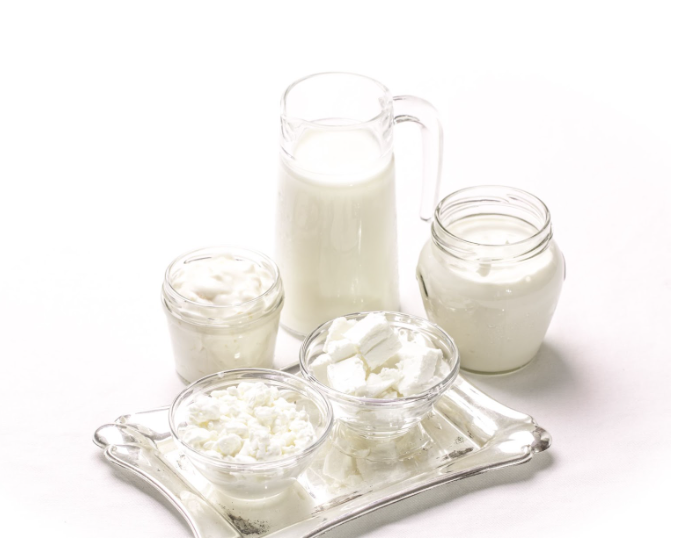Dairy Foods - More than Milk
Why do people hate dairy?
I find that one of the more polarizing food groups, even more than grains, is the dairy food group.
People get all worked up when suggesting we have this as part of our regular diet/intake.
And these same people eat cheese and yogurt. I am not making this up.
The recommendation is to have three cups of dairy from pre-teen years through adulthood.
And people think that I am recommending that they drink three glasses of milk a day. I am not. If that works, fine. But people hear “dairy” and assume it is milk in its liquid form.
“Dairy” includes yogurt, cheese, and liquid milk.
So, having milk in coffee or smoothie works, or having it on cereal counts.
Choosing a slice of cheese on a sandwich at lunch or shredded cheese in a salad counts toward these three cups.
Having yogurt as a snack works.
And this is potentially the three cups.
But wait: one cup is easy to measure and assess with liquid milk (8 ounces is 1 cup) and with yogurt (8 ounces is 1 cup).
Cheese is measured a bit differently. We don’t want to use measuring cups of cheese. One cup of cheese is not equivalent in most cases.
With sliced cheese or cheese sticks or bricks, that is 1-1 ½ ounces. That is the serving and equal to one cup of dairy.
With shredded cheese, ¼ to 1/3 cup is equal to one serving.
Cottage cheese is better as a protein source than calcium and potassium, so two cups are the serving size.
So, even if you don’t drink milk straight, you can still get dairy in your daily eating pattern.
Things we don’t count toward dairy intake: sour cream, half and half, cream, butter, and ice cream. There are probably other items that I am not thinking about now.
The reason is that hopefully, people aren’t consuming sour cream, half and half, and butter by the cup each day. Eating high amounts of butter is not a good idea (due to the very high saturated fat content and overall calories). One cup of butter is over 1,500 calories and virtually ALL fat. The protein and calcium content are inconsequential compared to the fat. And there are much better and healthier ways to get vitamin D.
Nutrients – More Than Just Calcium
All milk in the U.S. must be fortified with vitamins A and D. It is also a good source of calcium, potassium, riboflavin (vitamin B2), vitamin B12, and protein. There are plenty of other nutrients in there too. However, most people don’t even think about the protein and have no idea it has potassium.
Are you concerned about that fat? Okay, then choose the skim or low-fat versions. I’ve heard people talk about how milk is so high in fat, but it isn’t. Look at the label.
Arguments Against Dairy?
People have many arguments against dairy, which, when we consider them factually, are just not true or selectively used to support a weak argument.
For example, one argument is that humans are the only animal that drinks the milk of another animal.
Not true. There are many cases of animals adopting other animals and nursing animals outside of their species. Look it up. There are cases of dogs nursing baby tigers, kittens, and piglets. It happens. Nature is looking out for others.
Another argument: humans are the only animals that drink milk past infancy.
We are also the only ones who spend time on electronic devices, drive cars, ride bikes, watch television, go to restaurants, and sit in a classroom to get a formal education in the first 20 years or so of life. We are probably the only animals that know how to make yogurt and cheese.
Humans do a LOT of things those other animals don’t do. We have the intelligence to learn about how foods can benefit us.
Another argument: There is more calcium in a cup of broccoli (or insert other plant food here) than in a cup of milk.
Does it? I hear people say this all the time, but is this true? Not really. Here are the facts:
One cup of 1% milk has 310 mg of calcium.
One cup of raw broccoli has 35 mg of calcium.
One cup of cooked broccoli has 60 mg of calcium.
One would have to eat 10 cups of raw broccoli or five cups of cooked broccoli to get the same amount, which isn’t even considering the absorbability of that calcium.
What About Lactose Intolerance?
Another (legitimate) argument is lactose intolerance – which is NOT an allergy. The lactase enzyme in humans does naturally decline with age. But this doesn’t diminish at the same rate for everyone. I know adults in the 70s who can still tolerate milk with no issue, while some younger adults cannot. It varies by individual. Many people who cannot tolerate lactose can have yogurt because the live active cultures digest the lactose for us. Lactose-free milk also has the lactase enzyme added to it.
Plant-Based Milk/Dairy Alternatives
I have previously addressed plant-based milks and how they are not nutritionally equal. When looking at the nutrition profile, soy milk and pea-protein-based milk are the only ones I recommend as dairy alternatives. The other version does not have the same protein content and has many added ingredients. You can read more here or listen to the Real World Nutrition podcast episode 6.
USDA Food Data Central, Milk, lowfat, fluid 1% milkfat accessed Jun 6, 2022
USDA Food Data Central, Broccoli, raw, 1 cup accessed Jun 6, 2022

